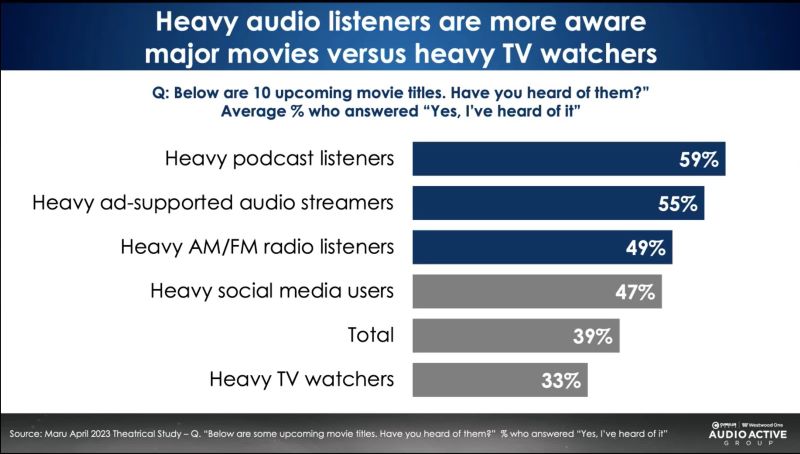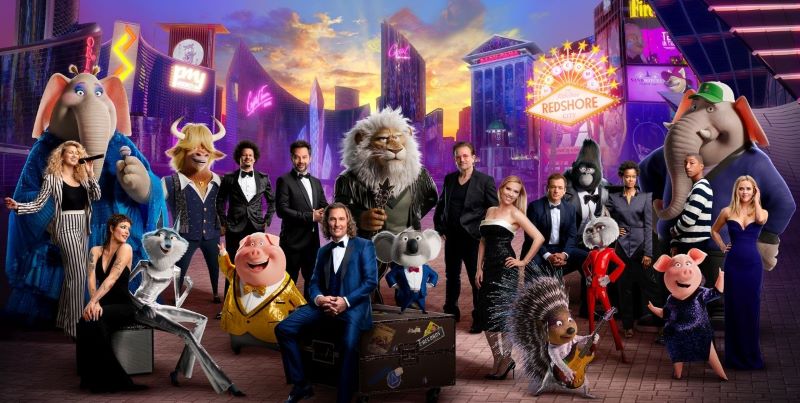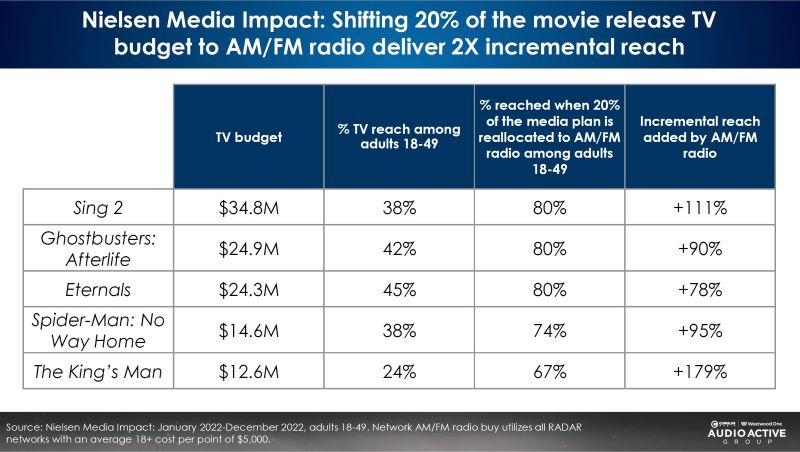
Radio is making its case that audio media merits a bigger slice of movie advertising budgets because it provides breadth — a wider swath of audiences than alternatives — and a higher percentage of heavy moviegoers.
At the moment, radio gets just 1-2% of movie advertising (linear TV and digital media gobble up around 95% of movie ad spending). In custom research commissioned by radio network Westwood One, movie audience researcher Screen Engine/ASI presents a marketing model asserting that shifting 20% of paid-advertising budgets for film campaigns to radio will double the audience reach. The research advocates for all audio media, including podcasting and streaming (such as Spotify) and is discussed in a blog by Westwood One chief insights officer Pierre Bouvard.
Reach is defined as consumers in a target demographic hit at least once with a message, usually expressed as a percentage.
Screen Engine/ASI made case studies of specific films to identify how changing media-advertising mix more toward radio would be beneficial. Its research panel is 2,300 consumers. Westwood One is owned by giant radio broadcaster Cumulus Media (whose properties include the former ABC Radio stations),
The research suggests that movie advertising campaigns with heavy TV/digital expenses don’t fully connect to a wide audience target demographic of frequent cinema-goers. Says Screen Engine/ASI, “A Nielsen analysis of five major film TV campaigns reveals 60% of the [ages] 18-49 demographic are missed. The $24.3 million-dollar TV campaign for Marvel’s ‘Eternals’ reached only 45% of the 18-49 demographic. The $34.8 million-dollar TV campaign for ‘Sing 2’ missed 62% of U.S. 18-49s.”
The commentary of Screen Engine/ASI analysis adds: “AM/FM radio to the rescue: Reallocating 20% of the linear TV investment to AM/FM radio cause campaign reach to double, according to Nielsen Media Impact.” The recommended reallocation of 20% of a film campaign spend on radio media consists of 58% for AM/FM radio, 28% for podcasts, 10% for Spotify/Pandora, and 4% for SiriusXM.

“The ‘Sing 2’ campaign would see the reach soar from 38% of 18-49s to 80%, a 2X increase,” says Screen Engine/ASI. “Shifting 20% of the ‘Eternals’ linear TV campaign to AM/FM radio would cause campaign reach to surge from 45% to 80%, an astonishing +78% lift in incremental reach.”
In an 8-minute Westwood One video, researcher Bouvard points to audience research in November by research company Maru focusing on just the 15% of the U.S. population that is defined as heavy cinema-goers (see top table on this page). Looking at just that slice of heavy moviegoers, “ad supported audio, whether it is podcast, streaming and AM-FM, together have the highest reach at 93% among this heavy moviegoer segment. So, ad supported audio has by far the biggest reach among American heavy moviegoers.”
The third edition of academic/business book “Marketing to Moviegoers” explains application of reach in marketing campaigns. “Reach is a metric that is valuable when evaluating multiple media buys that overlap,” says the book. “The media planner attempts to determine unduplicated audience delivery to minimize the size of the target audience that won’t see the advertisement.”
By the way, the opposite metric is “frequency,” which estimates the number of times each consumer or household receives a message, on average. So, frequency measures tonnage dropped on a specific population.

Taking a long look at film advertising, TV and digital media are audio/visual media, so their characteristics match film. That’s why they are popular with movie marketers.
On the other hand, radio-podcasting-music streaming are audio only, of course. But films are widely consumed, so marketing reach is important to connect to the full potential audience.
Bouvard argues that what industry refers to as “sight, sound and motion” in marketing is overrated because other factors match or trump in persuading movie audiences, such as recommendations from friends. To maximize the pool of friends recommending, consumers have to be aware of a film — hence reach is important.
Shifting 20% of existing movie marketing campaigns to radio would be a big change, but the radio advertising advocacy might get move the needle somewhat less, which still would be an accomplishment.
For the June release of “The Expendables 4,” the Screen Engine/ASI research found: AM/FM radio audiences are 16% more positive about the movie than the general population, so more predisposed than average. “Oldies/Classic Hits, Adult Contemporary, Classic Rock, Rock, Top 40, and News/Talk are just a few of the AM/FM radio programming formats with the greatest reach of those likely to see ‘The Expendables 4’ in theaters,” says Screen Engine/ASI.
Radio is an unusual medium because it has national reach, but typically not through a single pipeline. Rather, radio is distributed by a patchwork of local radio stations, which gives marketers the opportunity to tailor their messaging to local audiences, yet still achieve national coverage.
In addition, radio stations can be selected by their audience characteristics — their formats such as rock, country, talk, news, etc., each with different demographics. Radio stations are a popular medium for movie distributors to mount movie promotions, such as local sneak preview screenings, in promotions on top of any paid advertising (usually, promotions are paired with advertising buys because the station attracts the desired audience demographic).
iHeartRadio, which is the largest radio broadcast chain in the U.S., promotes the medium in a testimonial on-air blurb featuring Warner Bros. Pictures executive-vp worldwide marketing Dana Nussbaum.
“You have the ability to be very specific and very personalized, but at a tremendous scale,” says Nussbaum in the promotion. This means that, for any one flight of radio commercials, the message can be customized for the audience of each radio station.
Again, radio makes its case.
Leave a Reply